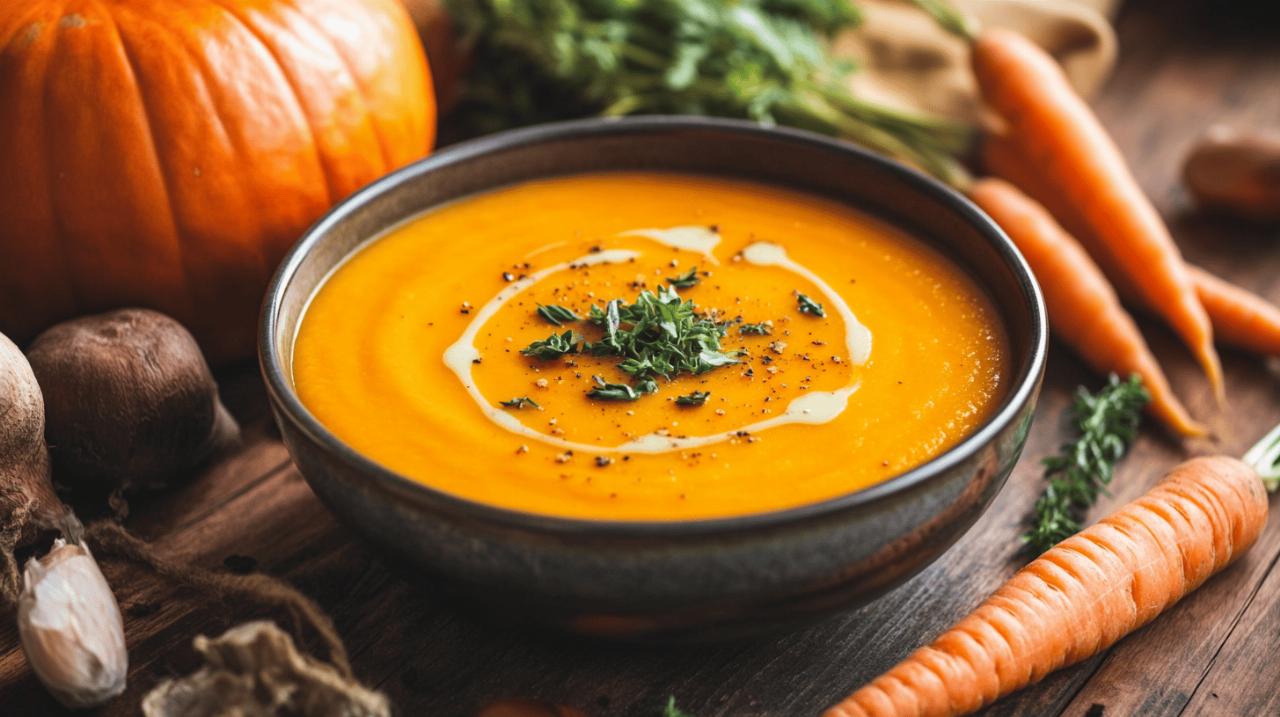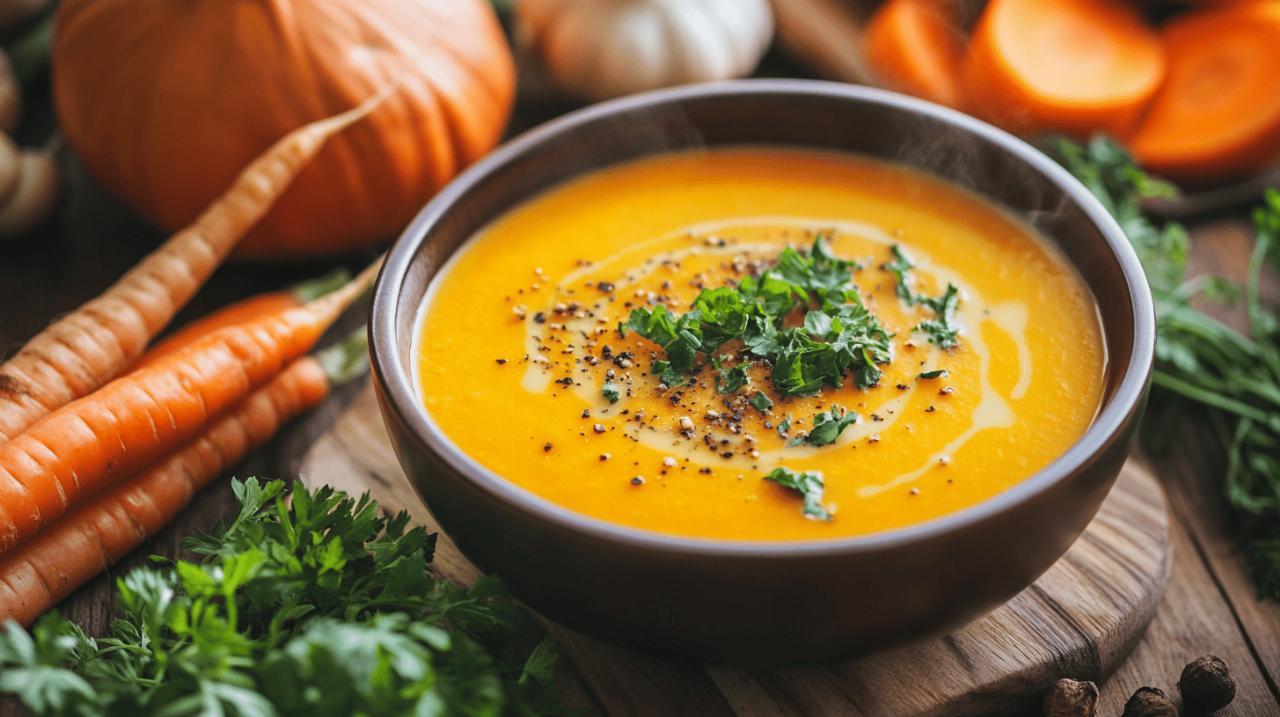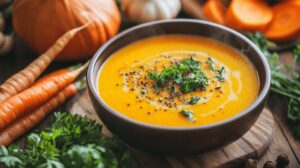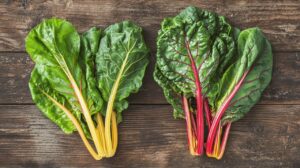The Recipe for Giraumon and Carrot Velouté: Traditional Root Vegetable Comfort for Cold Winter Nights
When the chill of winter sets in and frost begins to creep across windowpanes, there is nothing quite so restorative as a bowl of velvety soup that warms you from the inside out. This giraumon and carrot velouté brings together the gentle sweetness of root vegetables with the rich, earthy character of Caribbean pumpkin, creating a dish that is both comforting and nourishing. Perfect for those evenings when you crave something wholesome yet effortless, this traditional recipe transforms humble ingredients into a silky embrace that speaks to the soul.
Understanding giraumon: the star of this traditional velouté
What makes giraumon special in winter soups
Giraumon, a variety of pumpkin cherished in Mauritian cuisine, stands apart from its more commonplace cousins thanks to its delicate, slightly sweet flavour and dense, creamy flesh. Unlike the watery consistency found in some squashes, giraumon holds its shape beautifully during cooking, lending itself to smooth and luxurious preparations. Its natural sweetness pairs harmoniously with aromatic herbs and spices, making it an ideal foundation for a velouté that feels indulgent without being heavy. The vegetable has long been a staple in island kitchens, where cooks have perfected the art of coaxing out its subtle complexity through roasting and slow simmering. In winter soups, giraumon becomes the heart of the dish, its velvety texture transforming simple broths into something truly special.
Nutritional benefits of this caribbean pumpkin variety
Beyond its culinary appeal, giraumon offers a wealth of nutritional advantages that make it a wise choice for cold-weather cooking. Rich in beta-carotene, which the body converts into vitamin A, this pumpkin variety supports healthy vision and immune function during the months when our defences need bolstering most. Its high fibre content aids digestion and promotes a sense of lasting fullness, while its naturally low calorie profile makes it suitable for those mindful of their intake. The vegetable also contains valuable amounts of potassium, which helps maintain healthy blood pressure, and antioxidants that combat inflammation. When combined with carrots, another nutritional powerhouse, the resulting velouté becomes not just comfort food but a genuinely healthful addition to your winter repertoire.
Crafting the perfect root vegetable velouté
Essential Techniques for a Silky-Smooth Texture
Achieving the signature silkiness that defines a proper velouté requires attention to a few key techniques that elevate the dish from merely adequate to exceptional. The first consideration involves the initial preparation of your vegetables. Cutting them into uniform pieces ensures even cooking, which is crucial for achieving a consistent texture when blending. Roasting the giraumon before adding it to the pot deepens its flavour and caramelises its natural sugars, creating layers of complexity that would otherwise remain hidden. When it comes time to blend, patience proves essential. Allow your immersion blender or food processor to run longer than you might think necessary, as this extra time breaks down any remaining fibres and creates that coveted velvety mouthfeel. Some cooks find that passing the blended soup through a fine-mesh sieve removes any stubborn bits, resulting in an even more refined texture. Temperature matters as well; allowing the vegetables to cool slightly before blending prevents dangerous splattering and gives you better control over the process.
Balancing Flavours with Carrots and Aromatics
The marriage of giraumon and carrots creates a flavour profile that is both comforting and sophisticated, but achieving the right balance requires a thoughtful approach to aromatics and seasoning. Carrots contribute an earthy sweetness that complements rather than competes with the pumpkin, while their vibrant colour enriches the final presentation. Onions and garlic form the aromatic foundation, their pungency mellowing during cooking to provide savoury depth. Thyme and sage bring herbal notes that cut through the natural sweetness of the vegetables, whilst a bay leaf adds a subtle complexity that lingers on the palate. A touch of ground cinnamon introduces warmth without overwhelming the delicate vegetable flavours, and fresh turmeric lends both colour and a gentle earthiness. The key lies in restraint; each element should be discernible yet harmonious, creating a symphony rather than a cacophony. Tasting as you go allows you to adjust seasoning gradually, building layers of flavour that develop throughout the cooking process.
Step-by-Step Guide to Making Giraumon and Carrot Velouté
Preparing and cooking your vegetables properly
 Begin your velouté by gathering approximately half a kilogramme of giraumon, which you will need to peel, deseed, and cut into uniform cubes. Three medium carrots should be peeled and sliced into rounds of similar thickness to ensure they cook at the same rate. Finely chop one medium onion and mince two cloves of garlic, keeping them separate as they will be added to the pot at different stages. In a large, heavy-bottomed saucepan, warm a tablespoon of quality olive oil over medium heat until it shimmers gently. Add your chopped onion and allow it to soften for about five minutes, stirring occasionally to prevent browning. Once the onion becomes translucent and fragrant, introduce the minced garlic and cook for an additional minute, being careful not to let it burn. Add the giraumon and carrot pieces to the pan, stirring them to coat with the aromatic oil. Allow the vegetables to cook for roughly five minutes, during which time they will begin to soften and release their natural sugars. Pour in half a litre of broth, whether chicken or vegetable according to your preference, and tuck in several sprigs of fresh thyme along with a bay leaf. Bring the mixture to a gentle boil, then reduce the heat and let it simmer uncovered for approximately twenty minutes, or until the vegetables yield easily when pierced with a fork.
Begin your velouté by gathering approximately half a kilogramme of giraumon, which you will need to peel, deseed, and cut into uniform cubes. Three medium carrots should be peeled and sliced into rounds of similar thickness to ensure they cook at the same rate. Finely chop one medium onion and mince two cloves of garlic, keeping them separate as they will be added to the pot at different stages. In a large, heavy-bottomed saucepan, warm a tablespoon of quality olive oil over medium heat until it shimmers gently. Add your chopped onion and allow it to soften for about five minutes, stirring occasionally to prevent browning. Once the onion becomes translucent and fragrant, introduce the minced garlic and cook for an additional minute, being careful not to let it burn. Add the giraumon and carrot pieces to the pan, stirring them to coat with the aromatic oil. Allow the vegetables to cook for roughly five minutes, during which time they will begin to soften and release their natural sugars. Pour in half a litre of broth, whether chicken or vegetable according to your preference, and tuck in several sprigs of fresh thyme along with a bay leaf. Bring the mixture to a gentle boil, then reduce the heat and let it simmer uncovered for approximately twenty minutes, or until the vegetables yield easily when pierced with a fork.
Blending and finishing your winter warmer
Once your vegetables have reached tender perfection, remove the thyme sprigs and bay leaf before proceeding to the blending stage. If using a traditional blender, work in batches to avoid overfilling, taking care to hold the lid firmly as hot liquids can create pressure. For those equipped with an immersion blender, you may work directly in the pot, moving the blade in circular motions to ensure all ingredients are thoroughly incorporated. Blend until the mixture achieves a completely smooth consistency, which may take several minutes depending on your equipment. Return the pureed soup to the saucepan if you have used a countertop blender, then stir in two hundred millilitres of coconut milk, which adds richness and a subtle tropical note. If you prefer a more traditional finish, a couple of tablespoons of crème fraîche can be swirled in instead, though this is entirely optional. Taste the velouté carefully and adjust the seasoning with salt and freshly ground pepper, keeping in mind that flavours will develop further as the soup rests. Heat the mixture gently without allowing it to boil, which could cause the coconut milk to separate. Ladle the finished velouté into warmed bowls and garnish with freshly chopped parsley, a drizzle of extra virgin olive oil, or perhaps a few toasted pumpkin seeds for textural contrast.
Serving suggestions and creative variations
Garnishing ideas to elevate your velouté presentation
Whilst this velouté is delicious in its simplest form, thoughtful garnishing can transform it into something truly memorable. Crispy sage leaves, fried briefly in olive oil until they darken and become fragrant, add both visual appeal and a delightful textural contrast. A small dollop of thick yogurt or crème fraîche swirled into the centre creates an elegant pattern whilst adding a touch of tangy richness. Toasted seeds, whether pumpkin, sunflower, or sesame, provide a pleasant crunch and boost the nutritional profile. For those who enjoy a bit of heat, a pinch of chilli flakes or a drizzle of chilli oil introduces warmth without overwhelming the delicate vegetable flavours. Fresh herbs beyond parsley, such as coriander or finely sliced spring onions, bring brightness and colour to the presentation. Consider serving the velouté alongside crusty bread or homemade croutons rubbed with garlic, which are perfect for dunking and add substance to the meal.
Customising the Recipe for Different Dietary Preferences
One of the great strengths of this velouté lies in its remarkable adaptability to various dietary requirements and personal preferences. For those following a vegan lifestyle, simply omit the crème fraîche and ensure your broth is vegetable-based rather than chicken. The coconut milk provides sufficient creaminess without any dairy products whatsoever. Those adhering to paleo principles will find this recipe naturally compliant, as it relies entirely on whole vegetables, healthy fats, and bone or vegetable broth. For a heartier version, consider adding a grated potato or Japanese sweet potato during the simmering stage, which increases the body of the soup and adds extra sustenance. Additional root vegetables such as parsnips or turnips can be incorporated alongside or in place of some of the carrots, each bringing their own distinctive character to the finished dish. Those who prefer a more robust flavour might experiment with roasting all the vegetables before adding them to the broth, a technique that intensifies their natural sweetness and adds depth. The velouté also pairs beautifully with various beverages, from crisp white wines to craft beers with citrus notes, making it suitable for both casual family suppers and more formal entertaining.










